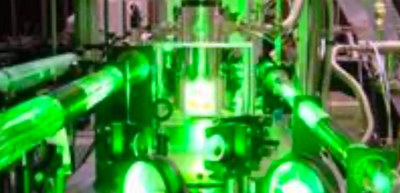
Strongest electric field produced by high intensity lasers will realize compact heavy ion accelerator systems
A group of researchers from the Kansai Photon Science Institute (KPSI) of the National Institutes for Quantum Science and Technology (QST), Osaka University, and Kyushu University has demonstrated that an electric field intensity of 83 teravolt (TV)/m (about 10 million times of the electric field intensity produced by a currently accessible laser system) was generated by irradiating a silver target at the PW (Peta Watt) laser facility J-KAREN-P (Japan-Kansai Advanced Relativistic Engineering Petawatt) and that silver ions were instantaneously accelerated to 20% of the speed of light.
Experiments at heavy-ion accelerators are used in studies of the origin of materials as well as the beginning and expansion of the universe. Heavy-ion accelerators can create extremely high-density states in which plasmas are created by accelerating particles to nearly the speed of light and colliding with other particles. However, in heavy ion accelerators, long path lengths (kilometers of transport distance) are necessary to accelerate particles to the speed of light.
For this reason, laser ion acceleration to generate ion beams with energies at various valences by irradiating a target by multi-petawatt laser draws attention as an efficient acceleration technique that can significantly scale down the size of accelerators.
In this study, the researchers carried out ion acceleration with the J-KAREN-P laser facility at QST, in which they increased the maximum energies of silver ions by varying the silver foil thickness to optimize the temporal pulse shape.
They demonstrated (a) the generation of an electric field intensity of 83TV/m (the highest value, about 10 million times stronger than electric fields in thunderclouds), (b) the generation of 45 valence electrons, and (c) the acceleration of silver ions to 20% of the speed of light, the highest value.
Analysis of the results of these experiments showed that the temporal pulse shape (rising edge in PW-class laser pulses) played an important role in the ionization and generation dynamics of an ultra-intense laser-driven electric field.
This suggests that this group’s technique is effective for a laser-driven ion acceleration of both heavy and light elements and that it can be used as a guideline for a laser-driven high energy acceleration of protons and light element ions. Based on the findings in this study, QST will aim to realize a quantum scalpel, a next-generation ultra-compact heavy-ion beam therapy system.
As high intensity laser systems develop, the acceleration of heavier elements to high energy will become possible. This will make it possible to perform studies and experiments at laboratory facilities, for example, cosmic physics research to solve the mysteries of the universe, as well as nuclear physics experiments to produce short-lived nuclides.
Figure 1
FIgure 2
Figure 3
Figure 4
Figure 5
The article, “Dynamics of laser-driven heavy-ion acceleration clarified by ion charge states”, was published in Physical Review Research at DOI: https://journals.aps.org/prresearch/abstract/10.1103/PhysRevResearch.2.033081.
